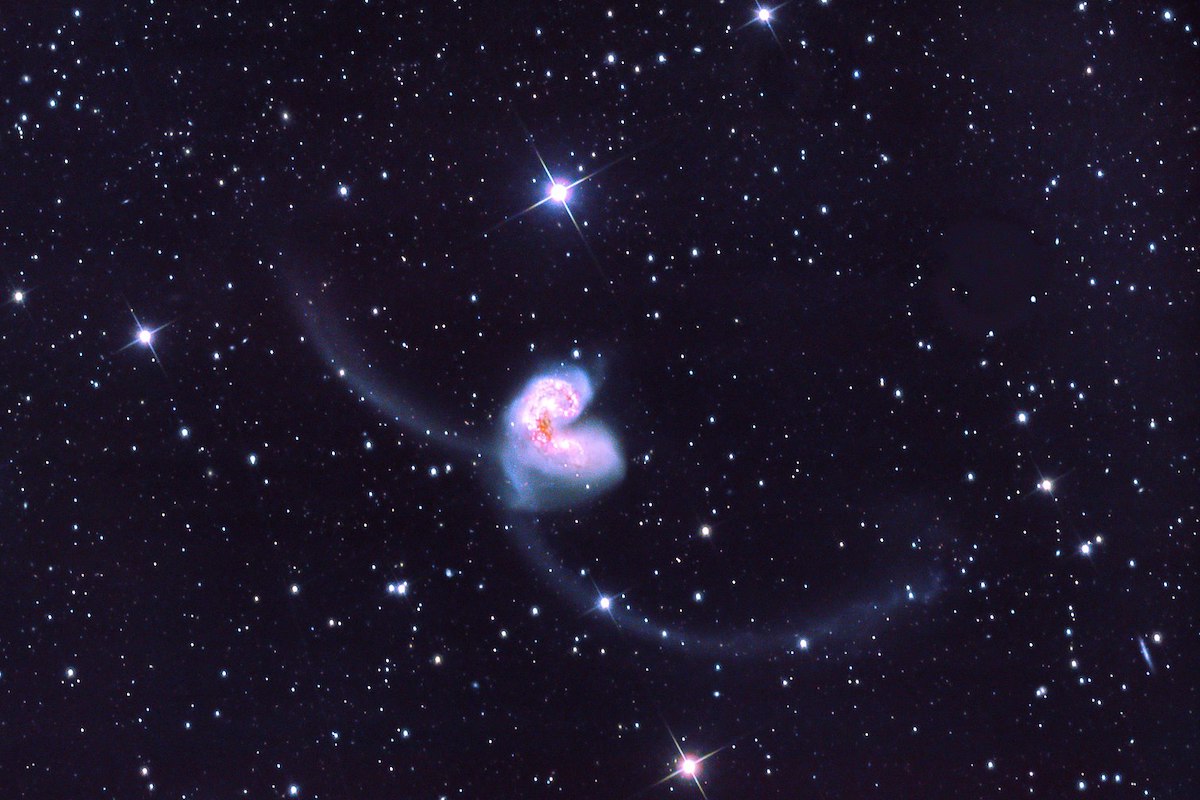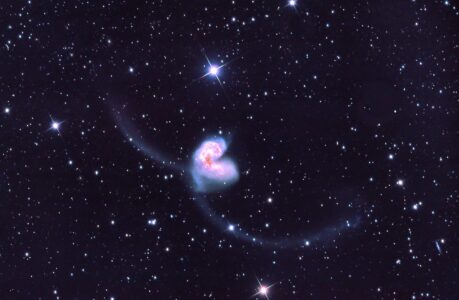Antennae Galaxies, also known as NGC 4038 and NGC 4039, are a pair of interacting galaxies located in the constellation Corvus. These two galaxies are in the process of colliding with each other, creating a spectacular display of cosmic destruction and creation that has fascinated astronomers and stargazers for decades.
The Antennae Galaxies were first discovered by William Herschel in 1785. They are located approximately 45 million light-years away from Earth and are part of the Antlia Cluster of galaxies. The two galaxies are currently interacting with each other, and the collision has triggered a burst of star formation, as well as the formation of new structures in the galaxies.
The Antennae Galaxies are named for their long, curved antenna-like arms that extend from each galaxy. These arms are made up of gas and dust, and they are the sites of intense star formation. The galaxies also have bright cores, which are the result of the collision of their respective supermassive black holes.
The collision between the Antennae Galaxies began about 500 million years ago and is still ongoing. The galaxies are in the process of merging, and they will eventually form a single, larger galaxy. The collision has caused a tremendous amount of gas and dust to be compressed and heated, leading to the formation of new stars.
One of the most fascinating features of the Antennae Galaxies is the formation of tidal tails. These are long, thin streams of stars and gas that have been pulled out of the galaxies by the gravitational forces of the collision. The tidal tails can extend for hundreds of thousands of light-years, and they are a testament to the immense power of the collision.
The collision between the Antennae Galaxies has also had a profound impact on the supermassive black holes at their centers. The two black holes are currently orbiting each other, and they will eventually merge into a single black hole. The collision has also caused the black holes to become more active, as they feed on the gas and dust that has been compressed by the collision.
The Antennae Galaxies are a favorite target of astronomers because of their stunning beauty and the insights they provide into the processes that shape the universe. Observations of the galaxies have been made in a wide range of wavelengths, from radio waves to X-rays, providing a comprehensive picture of the collision and its aftermath.
In conclusion, the Antennae Galaxies are a magnificent example of the power and beauty of the universe. The collision between these two galaxies has created a stunning display of destruction and creation that continues to captivate astronomers and stargazers alike. As we continue to study these galaxies, we will gain a deeper understanding of the processes that shape our universe and the incredible power of the cosmos.
NGC 4038
NGC 4038 is one of the two galaxies that make up the Antennae Galaxies. It is a barred spiral galaxy, which means it has a central bar-shaped structure made up of stars and gas. The galaxy has a diameter of approximately 65,000 light-years, making it slightly smaller than the Milky Way.
NGC 4038 is located in the southern hemisphere, in the constellation Corvus. The galaxy was first discovered by William Herschel in 1785 and was later included in the New General Catalogue (NGC), a catalog of deep-sky objects compiled by John Louis Emil Dreyer in the late 19th century.
Like the other galaxy in the Antennae pair, NGC 4038 is undergoing a collision with its neighbor NGC 4039. The collision has caused a burst of star formation in both galaxies and has created tidal tails of stars and gas that stretch for hundreds of thousands of light-years.
NGC 4038 has several notable features that have made it a favorite target of astronomers. One of these features is a prominent ring of star formation surrounding the galaxy’s central bar. This ring is made up of dense clouds of gas and dust that are being compressed by the collision with NGC 4039, triggering the formation of new stars.
Another feature of NGC 4038 is a group of young, massive star clusters located in the tidal tails. These clusters are believed to have formed as a result of the collision, and their properties can provide valuable insights into the process of star formation in extreme environments.
Observations of NGC 4038 have been made in a wide range of wavelengths, from radio waves to X-rays. These observations have revealed a wealth of information about the galaxy’s structure, star formation, and interaction with NGC 4039.
Overall, NGC 4038 is a fascinating object for astronomers and stargazers alike. Its ongoing collision with NGC 4039 is a testament to the dynamic and ever-changing nature of the universe, and studying the galaxy can provide valuable insights into the processes that shape our cosmos.
NGC 4039
NGC 4039 is one of the two galaxies that make up the Antennae Galaxies. It is an irregular galaxy, which means it does not have a well-defined shape or structure like spiral or elliptical galaxies. The galaxy has a diameter of approximately 90,000 light-years, making it slightly larger than the Milky Way.
NGC 4039 is located in the southern hemisphere, in the constellation Corvus. The galaxy was also first discovered by William Herschel in 1785 and was later included in the New General Catalogue (NGC).
Like its neighbor NGC 4038, NGC 4039 is undergoing a collision that has triggered a burst of star formation in both galaxies. The collision has also created tidal tails of stars and gas that stretch for hundreds of thousands of light-years.
One of the most notable features of NGC 4039 is a prominent bridge of gas and dust connecting it to NGC 4038. This bridge is made up of material that has been stripped from both galaxies by the gravitational forces of the collision.
NGC 4039 also has several young, massive star clusters located in its tidal tails. These clusters are believed to have formed as a result of the collision, and their properties can provide valuable insights into the process of star formation in extreme environments.
Observations of NGC 4039 have been made in a wide range of wavelengths, from radio waves to X-rays. These observations have revealed a wealth of information about the galaxy’s structure, star formation, and interaction with NGC 4038.
Overall, NGC 4039 is a fascinating object for astronomers and stargazers alike. Its ongoing collision with NGC 4038 is a stunning example of the power and beauty of the universe, and studying the galaxy can provide valuable insights into the processes that shape our cosmos.
The constellation of Corvus
The constellation of Corvus is a small, faint constellation located in the southern hemisphere. It is one of the 88 modern constellations recognized by the International Astronomical Union (IAU) and was first cataloged by the Greek astronomer Ptolemy in the 2nd century.
The name Corvus means “crow” in Latin, and the constellation is often depicted as a crow or raven in mythology. In Greek mythology, the god Apollo sent a crow to fetch a cup of water, but the crow got distracted and delayed its return. As a punishment, Apollo cast the crow into the sky, where it became the constellation Corvus.
Corvus is bordered by the constellations Hydra to the east, Crater to the south, Virgo to the west, and Leo to the north. It is a small constellation, covering an area of only 184 square degrees. The brightest star in Corvus is Gienah, also known as Gamma Corvi, which has a magnitude of 2.59 and is located approximately 160 light-years away from Earth.
Despite its small size and faint stars, Corvus contains several notable deep-sky objects. The most famous of these is the Antennae Galaxies, a pair of interacting galaxies that are undergoing a collision and creating a stunning display of cosmic destruction and creation. The galaxies, NGC 4038 and NGC 4039, are located near the border of Corvus with the neighboring constellation Virgo.
Corvus is also home to several other galaxies, including NGC 4361, NGC 4365, and NGC 4027. These galaxies are much fainter than the Antennae Galaxies but are still fascinating objects for astronomers to study.
Overall, the constellation of Corvus may be small and faint, but it contains some of the most fascinating and beautiful objects in the night sky. From the stunning collision of the Antennae Galaxies to the distant glow of faint galaxies, Corvus provides a wealth of opportunities for astronomers to explore the wonders of the universe.

